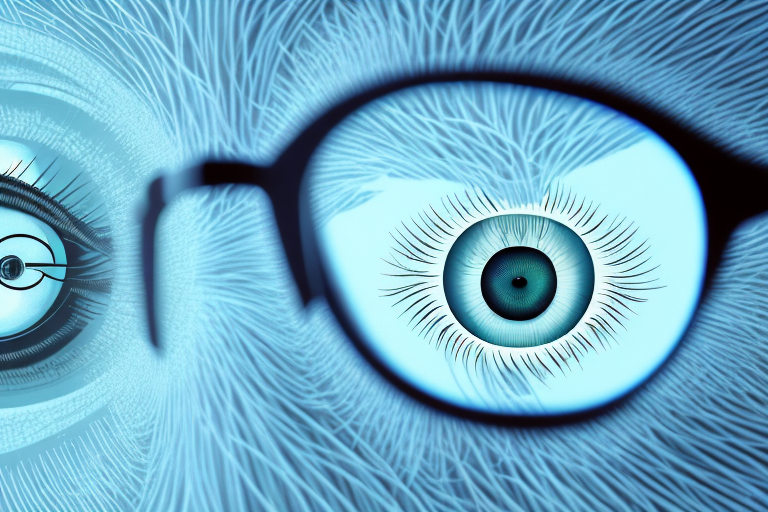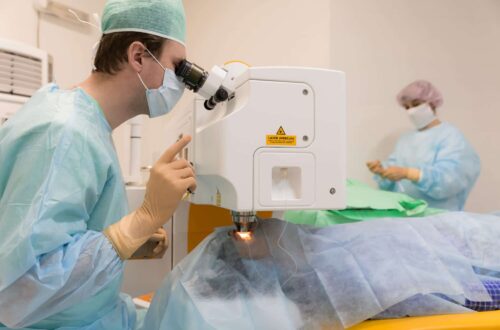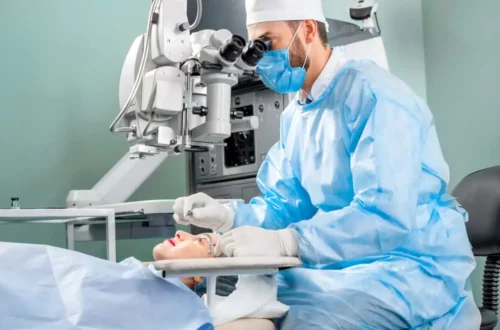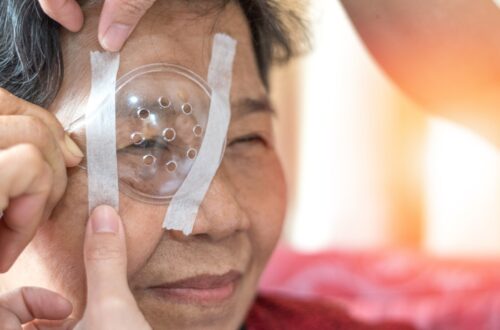
Combating Nearsightedness with Laser Eye Surgery
In recent years, laser eye surgery has emerged as an effective solution for nearsightedness. This revolutionary procedure aims to correct vision problems caused by nearsightedness, allowing individuals to enjoy clear eyesight without the need for glasses or contact lenses. If you’re tired of depending on visual aids to see the world around you, understanding the ins and outs of laser eye surgery could be the first step towards a life without visual limitations.
Understanding Nearsightedness
Before delving into the intricacies of laser eye surgery, it’s important to grasp the concept of nearsightedness. Also known as myopia, this common vision condition causes objects in the distance to appear blurry, while close-up vision remains relatively clear. Nearsightedness occurs when the eyeball is longer than average or the cornea, the clear front surface of the eye, is too curved. As a result, light entering the eye doesn’t focus correctly on the retina, leading to blurred vision.
The Science Behind Nearsightedness
In order to fully grasp how laser eye surgery combats nearsightedness, one must delve into the science behind this condition. Nearsightedness is often attributed to a combination of genetic and environmental factors. Those with a family history of myopia are more likely to develop nearsightedness, as are individuals who spend an excessive amount of time engaging in near work, such as reading or using digital devices.
Genetic factors play a significant role in the development of nearsightedness. Research has shown that if both parents have myopia, their children are at a higher risk of developing the condition. However, it is not solely determined by genetics. Environmental factors also contribute to the development and progression of nearsightedness. For example, spending excessive time indoors and engaging in activities that require close-up focus, such as reading or using electronic devices, can increase the likelihood of developing nearsightedness.
When it comes to the anatomy of the eye, nearsightedness is primarily caused by the shape of the eyeball. In individuals with myopia, the eyeball is longer than average, which causes the light entering the eye to focus in front of the retina instead of directly on it. Another factor that can contribute to nearsightedness is the curvature of the cornea. If the cornea is too curved, it can also cause light to focus in front of the retina, resulting in blurred distance vision.
Common Symptoms and Diagnosis
Recognizing the signs of nearsightedness is crucial in addressing this condition before it worsens. Some common symptoms of nearsightedness include blurred vision, difficulty reading road signs, eyestrain, and frequent headaches. If you suspect you may have nearsightedness, it’s important to seek professional diagnosis from an optometrist or ophthalmologist, who will perform a comprehensive eye examination to determine the severity of your condition.

During an eye examination, the optometrist or ophthalmologist will conduct various tests to assess your visual acuity and determine the extent of your nearsightedness. One of the most common tests is the visual acuity test, where you are asked to read letters or symbols on a chart from a specific distance. This test helps determine the clarity of your vision at different distances.
In addition to the visual acuity test, your eye care professional may also perform a refraction test to determine the exact prescription needed to correct your nearsightedness. This test involves looking through a series of lenses while the doctor fine-tunes the prescription to find the best combination for your vision.
Furthermore, the doctor may use a retinoscope, a handheld instrument that shines a light into your eye, to evaluate the way light reflects off your retina. This helps determine the degree of nearsightedness and any other refractive errors that may be present.
Overall, a comprehensive eye examination is essential in diagnosing nearsightedness accurately. Once diagnosed, you and your eye care professional can discuss the available treatment options, including laser eye surgery, to correct your vision and improve your quality of life.
An Overview of Laser Eye Surgery
Laser eye surgery has revolutionized the field of vision correction, offering individuals with nearsightedness newfound freedom from visual aids. This minimally invasive procedure reshapes the cornea, allowing light to properly focus on the retina, thus improving vision. While there are several types of laser eye surgeries available, the most common techniques include LASIK (Laser-Assisted In Situ Keratomileusis) and PRK (Photorefractive Keratectomy).
How Laser Eye Surgery Works
Laser eye surgery reshapes the cornea using an excimer laser, which delivers precise bursts of ultraviolet light to remove tiny amounts of corneal tissue. By carefully sculpting the cornea’s curvature, the surgeon can correct refractive errors, such as nearsightedness. The procedure itself is relatively quick, usually lasting no longer than 30 minutes per eye, and is typically painless due to the use of numbing eye drops.
During the surgery, the patient lies on a reclining chair while the surgeon uses a special microscope to view the eye. A small device called a speculum is used to hold the eyelids open, ensuring a clear view of the cornea. The surgeon then creates a thin flap on the cornea using a microkeratome or a femtosecond laser, depending on the chosen technique. Visit https://brain-gate.org/things-you-should-know-before-visiting-a-sydney-eye-clinic/ to read about Things you should know before visiting a Sydney eye clinic.
For LASIK, the flap is lifted, exposing the underlying corneal tissue. The excimer laser is then used to remove precise amounts of tissue, reshaping the cornea to the desired curvature. Once the reshaping is complete, the flap is carefully repositioned, acting as a natural bandage for the healing process.
In PRK, the outer layer of the cornea, called the epithelium, is completely removed before the laser reshaping begins. This allows direct access to the corneal tissue, but it also means a longer healing time compared to LASIK. After the laser treatment, a soft contact lens is placed on the eye to protect the healing cornea and provide comfort.
Different Types of Laser Eye Surgeries
There are different types of laser eye surgeries available, each catering to specific needs and preferences. LASIK is the most popular option, as it involves creating a thin flap on the cornea, which is then lifted to allow the reshaping of the underlying tissue. This technique offers a faster recovery time and minimal discomfort for most patients.
PRK, on the other hand, involves removing the thin outer layer of the cornea before proceeding with the laser reshaping. While the initial recovery period may be longer compared to LASIK, PRK can be a suitable choice for individuals with thin corneas or other corneal irregularities that make them unsuitable candidates for LASIK.
In addition to LASIK and PRK, there are other types of laser eye surgeries available, such as LASEK (Laser Epithelial Keratomileusis) and SMILE (Small Incision Lenticule Extraction). LASEK combines elements of both LASIK and PRK, while SMILE is a newer technique that involves creating a small incision to remove a lenticule from within the cornea, reshaping its curvature.
Your surgeon will determine which procedure is best suited for your individual case after a thorough examination of your eyes and discussion of your visual needs and expectations. It is important to consult with a qualified ophthalmologist to understand the benefits, risks, and potential outcomes of each technique.
The Benefits of Laser Eye Surgery for Nearsightedness
Laser eye surgery offers a multitude of benefits for individuals with nearsightedness, providing them with improved vision and a greater quality of life.
Long-Term Vision Improvement
One of the key advantages of laser eye surgery is the long-term improvement in vision it provides. Following the procedure, many patients experience significantly enhanced eyesight, allowing for clearer and sharper vision without the need for glasses or contacts. The visual improvement achieved through laser eye surgery is typically permanent, offering a lasting solution to nearsightedness.
Imagine waking up in the morning and being able to see the world around you with crystal clarity. With laser eye surgery, this dream can become a reality. No longer will you have to reach for your glasses or fumble for your contact lenses. Laser eye surgery can give you the freedom to enjoy life without the constant reliance on corrective eyewear.
Not only does laser eye surgery improve your vision, but it also enhances your overall quality of life. Imagine being able to engage in activities such as swimming, playing sports, or simply enjoying a book without the hassle of glasses or the discomfort of contacts. Laser eye surgery can open up a whole new world of possibilities and experiences.
Quick Recovery Time
Another noteworthy benefit of laser eye surgery is its quick recovery time. While some discomfort and dryness may be experienced temporarily, most patients are able to resume normal activities within a day or two after the procedure. Compared to other surgeries, such as cataract surgery, laser eye surgery offers a relatively short healing period, enabling individuals to swiftly return to their daily routines.
Imagine undergoing a surgical procedure in the morning and being able to go about your day as usual by the next day. Laser eye surgery allows for a speedy recovery, minimizing the disruption to your daily life. Within a short period of time, you can enjoy the full benefits of the surgery and experience the world with improved vision.
Furthermore, the quick recovery time of laser eye surgery means that you won’t have to take an extended leave from work or put your life on hold. You can schedule the procedure at a convenient time and be back on your feet in no time. This makes laser eye surgery a practical choice for individuals with busy lifestyles who cannot afford to be sidelined for long periods.
Potential Risks and Complications
While laser eye surgery has proven to be a safe and effective procedure, it’s important to be aware of the potential risks and complications that may arise.
Short-Term Side Effects
Following laser eye surgery, some patients may experience short-term side effects such as dry eyes, glare, halos, or fluctuating vision. These side effects are usually temporary and typically diminish within a few days or weeks after the surgery. Your surgeon will provide you with detailed instructions on how to alleviate any discomfort and manage these temporary visual disturbances.
Long-Term Risks
While rare, there are potential long-term risks associated with laser eye surgery. These risks may include regression, which refers to a gradual return of nearsightedness over time, or the development of corneal ectasia, a condition characterized by a thinning and bulging of the cornea. However, with thorough pre-operative evaluations and appropriate post-operative care, the chance of experiencing any significant long-term complications is greatly minimized.
Preparing for Laser Eye Surgery
Preparing for laser eye surgery involves several key steps to ensure a successful outcome and minimize any potential risks.
Initial Consultation and Eye Examination
The first step in preparing for laser eye surgery is scheduling an initial consultation with a qualified ophthalmologist. During this appointment, the surgeon will conduct a comprehensive eye examination to evaluate the health of your eyes and determine your eligibility for the procedure. Factors such as corneal thickness, refractive error, and overall eye health will be taken into consideration to ensure optimal results.
Pre-Surgery Guidelines
In the days leading up to the surgery, your surgeon will provide you with specific pre-surgery guidelines to follow. These may include temporarily discontinuing the use of contact lenses, avoiding certain medications, and refraining from wearing eye makeup on the day of the surgery. By adhering to these guidelines, you can help ensure the best possible outcome for your laser eye surgery.
In conclusion, laser eye surgery offers an effective solution for combating nearsightedness. By understanding the science behind nearsightedness, exploring the various types of laser eye surgeries, weighing the benefits against the potential risks, and adequately preparing for the procedure, individuals with nearsightedness can take the necessary steps towards achieving clear, unaided vision. Consult with a qualified eye surgeon to determine whether laser eye surgery is the right option for you and embark on a journey towards better eyesight.




